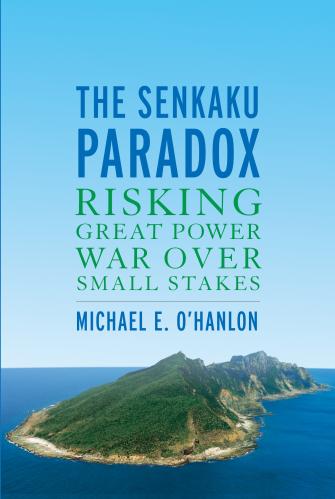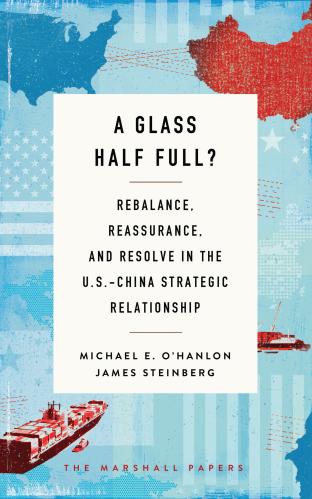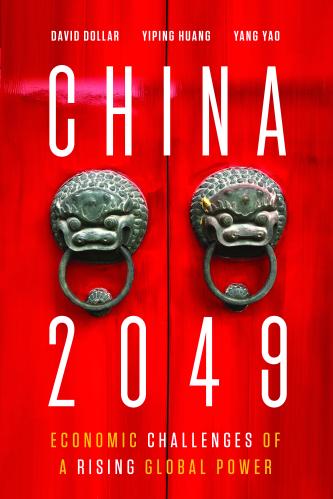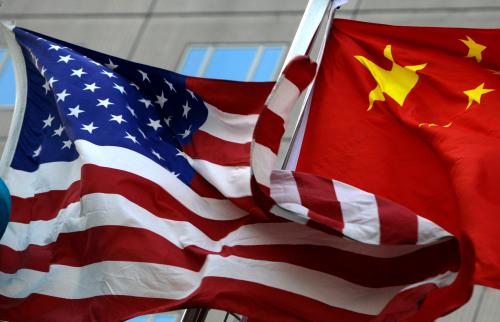The Department of Defense has just released its latest annual report, continuing a two-decade tradition, on China’s military and its role in China’s broader foreign policy. It is a serious read; I commend Secretary of Defense Mark Esper and his team for a thorough, dispassionate, and timely piece of work. The report also builds on Esper’s summertime assessment of where things stand with implementation of the 2018 National Defense Strategy (NDS), which he inherited from former Secretary of Defense Jim Mattis. That NDS placed primary emphasis on great-power competition, with particular focus on China, and has been been Esper’s main focus since becoming secretary in mid-2019.
Overall, the new report is very good, but I would offer several comments on specifics. Relatedly, a new Foreign Affairs article by Richard Haass and David Sacks of the Council on Foreign Relations — arguing that the United States should be clear that it would respond to any Chinese attack on Taiwan with a resolute reply, even though the latter is not a formal U.S. ally — prompts me to caution that improvements in Chinese military power may mean that indirect defense of Taiwan could be better in some contingencies.
The Pentagon’s findings
The Department of Defense (DoD) report reads:
DoD’s 2000 report assessed that the PLA was slowly and unevenly adapting to the trends in modern warfare. The PLA’s force structure and capabilities focused largely on waging large-scale land warfare along China’s borders. The PLA’s ground, air, and naval forces were sizable but mostly obsolete. Its conventional missiles were generally of short range and modest accuracy. The PLA’s emergent cyber capabilities were rudimentary; its use of information technology was well behind the curve; and its nominal space capabilities were based on outdated technologies for the day. Further, China’s defense industry struggled to produce high-quality systems. Even if the PRC could produce or acquire modern weapons, the PLA lacked the joint organizations and training needed to field them effectively. The report assessed that the PLA’s organizational obstacles were severe enough that if left unaddressed they would “inhibit the PLA’s maturation into a world-class military force.
This is a good scene-setter. Chinese forces had of course been formidable in some ways a full half-century before even this first DoD report on the People’s Liberation Army (PLA) was penned in 2000 — fighting ferociously against U.S. and South Korean forces in the Korean War. But until recent years, China had always remained a low-tech ground power, and did not have a realistic option even for conquering nearby Taiwan, a polity with less than 2% the population of mainland China.
Two decades later, the PLA’s objective is to become a “world-class” military by the end of 2049—a goal first announced by General Secretary Xi Jinping in 2017. Although the CCP [Chinese Communist Party] has not defined what a “world-class” military means, within the context of the PRC’s national strategy it is likely that Beijing will seek to develop a military by mid-century that is equal to—or in some cases superior to—the U.S. military, or that of any other great power that the PRC views as a threat. As this year’s report details, the PRC has marshaled the resources, technology, and political will over the past two decades to strengthen and modernize the PLA in nearly every respect.
Again, this is somber but sober and clear-eyed analysis. With most expecting China’s economy to be considerably larger than America’s by mid-century, and with China now having the second-largest research and development budget in the world for science and technology, it certainly is a plausible aspiration. That said, at this point, anything about 2049 is aspirational. It is also worth bearing in mind how much demographics, and possibly the “middle-income trap,” will work against China, compromising its growth prospects substantially. My Brookings colleague David Dollar even thinks that the United States may again overtake China in gross domestic product (GDP) by the second half of the century, even if China had previously become the world’s largest economy in the 2030s or 2040s.
Indeed, as this report shows, China is already ahead of the United States in certain areas such as:
Shipbuilding: The PRC has the largest navy in the world, with an overall battle force of approximately 350 ships and submarines including over 130 major surface combatants. In comparison, the U.S. Navy’s battle force is approximately 293 ships as of early 2020.
I have big issues with this simplistic argument. The United States has much larger and more sophisticated ships than China. As research done with my colleagues Ian Livingston and Adam Twardowski has shown in recent years (and as Jim Steinberg and I underscored in our 2014 book “Strategic Reassurance and Resolve”), America’s Navy remains way ahead in tonnage — still by a factor of at least two-to-one over China’s. It is ahead by at least ten-to-one in carrier-based airpower. It is way ahead, too, in the quality and quantity of long-range attack submarines, even if China now has a fine force of shorter-range and mostly nonnuclear-powered attack subs itself. In fairness, it should also be acknowledged that many of China’s new ships are well-equipped with launch tubes and modern missiles — as Jerry Hendrix and others have argued — so the PLA Navy does have considerable strengths, no doubt. I am not counseling complacency with this assessment, only analytical accuracy and balance.
Land-based conventional ballistic and cruise missiles: The PRC has more than 1,250 ground-launched ballistic missiles (GLBMs) and ground-launched cruise missiles (GLCMs) with ranges between 500 and 5,500 kilometers. The United States currently fields one type of conventional GLBM with a range of 70 to 300 kilometers and no GLCMs.
Here DoD has a point. And the threat to U.S. assets in the western Pacific from these kinds of Chinese weapons has indeed grown enormously in recent times.
The United States was a party to the Intermediate-Range Nuclear Forces Treaty (INF Treaty) with Russia until earlier this year; that treaty prohibited any type of mid-range ballistic or cruise missile, whether arrayed against Russia or any other state, irrespective of the type of munition carried. As my colleague Frank Rose emphasizes, it is also not clear where the United States would base intermediate-range missiles in the western Pacific region. Those are the reasons the United States is outgunned in these weapons categories today.
There is a case that the DoD should consider building medium-range missiles, if we can figure out where and how to base them (on land, at sea, or with long-range airpower). But there are many ways for the United States to strike Chinese missile launchers, including with long-range stealth aircraft, a category of capability the United States still dominates. So yes, let’s watch this space, but not be too surprised or flummoxed that we are presently at a specific disadvantage in this type of armament.
Integrated air defense systems: The PRC has one of the world’s largest forces of advanced long-range surface-to-air systems—including Russian-built S-400s, S-300s, and domestically produced systems—that constitute part of its robust and redundant integrated air defense system architecture.
Agreed, though this system is really relevant only for defending China, not for projecting power abroad.
More striking than the PLA’s staggering amounts of new military hardware are the recent sweeping efforts taken by CCP leaders that include completely restructuring the PLA into a force better suited for joint operations, improving the PLA’s overall combat readiness, encouraging the PLA to embrace new operational concepts, and expanding the PRC’s overseas military footprint. Despite the PLA’s progress over the past 20 years, major gaps and shortcomings remain. The PRC’s leaders are aware of these problems, and their strategy envisions the PLA undergoing almost 30 more years of modernization and reform. Of course, the CCP does not intend for the PLA to be merely a showpiece of China’s modernity or to keep it focused solely on regional threats. As this report shows, the CCP desires the PLA to become a practical instrument of its statecraft with an active role in advancing the PRC’s foreign policy, particularly with respect to the PRC’s increasingly global interests and its aims to revise aspects of the international order.
This is true. But China’s roughly $200 billion annual budget, according to DoD (even after adding in many things that China leaves out of its own official defense budget figures), represents only about 1.5% of the country’s GDP. China does not seem to be in any huge hurry to build and flex its muscles. It is far and away the world’s #2 military power, but it only spends about one-third as much as the United States on its armed forces in absolute terms and only about one-half as much as a fraction of national economic output. If China were in NATO, we would berate it for inadequate burden-sharing, since its military outlays fall well below NATO’s 2% minimum.
Still, let me not overstate: With the huge size of its economic and manufacturing base, China does indeed have the capacity to devote lots of resources to its armed forces. And it does so in a targeted way, increasingly focused on power-projection capabilities for the western Pacific and beyond. It does not have the combat experience of American armed forces from, among other things, the wars of the broader Middle East this century. But nor does it have those kinds of burdens or drains that take away from its real military priorities.
Given the continuity in the PRC’s strategic objectives, the past 20 years offer a harbinger for the future course of the PRC’s national strategy and military aspirations. Certainly, many factors will determine how this course unfolds. What is certain is that the CCP has a strategic end state that it is working towards, which if achieved and its accompanying military modernization left unaddressed, will have serious implications for U.S. national interests and the security of the international rules-based order.
Yes, and my colleague Rush Doshi also underscores that China has a clear grand strategy with specific goals. However, I do not believe China has decided that the maximization of those objectives is worth a high risk of war. It will more likely be opportunistic. Hence, much of the U.S. role is to push back with an integrated mix of military, economic, and diplomatic responses to various attacks, probing actions, or coercive actions that China may (and will) attempt in future years.
Defending Taiwan
The recent Foreign Affairs piece by Richard Haass and David Sacks calls for Washington to be clear with Beijing: that it would respond to any Chinese attack on Taiwan firmly and resolutely, even though Taiwan is not a formal U.S. ally. This approach would, of course, reverse a policy of ambiguity now four decades old.
If what Haass and Sacks mean is that the United States could not be indifferent to any such attack, I agree completely. And if they mean that we should help Taiwan fend off an attempted amphibious attack (that DoD does not consider likely according to its latest report, by the way, which notes the inherent difficulty of such amphibious operations, and China’s lack of key investments in some assets needed for forcible entry), I am not even sure that Taiwan would need the help.
However, were China to use a partial blockade, cyberattacks, and some menacing missile strikes against Taiwan in an attempt to coerce it into capitulation and forced reunification, for example, it is not clear to me that the United States could confidently defeat that PLA strategy. Geography works heavily to China’s advantage in such a scenario. To win, we might wind up feeling the need to attack Chinese submarines in port, missile launchers on mainland soil, and Chinese command and control networks that are also used for China’s nuclear arsenal. Escalation could certainly ensue; China could easily respond with attacks against U.S. bases in Japan or beyond. Any such scenario would be highly fraught and not easily or confidently won.
Overall, then, I would caution that with all the improvements in Chinese military power the Pentagon report documents, it may make more sense to attempt an indirect defense of Taiwan in such a contingency. Rather than try to break a blockade comprehensively and directly, for example, we might place primary reliance on geographically asymmetric operations against Chinese shipping in the Persian Gulf, for example, together with moves towards a fundamental decoupling of our economy from China’s as a punitive measure. These approaches would themselves be dangerous, and painful — and they might not immediately rescue Taiwan, it is true, as I discuss in my 2019 book, “The Senkaku Paradox.” But they would have a much lower chance of escalating to what could become World War III. At a minimum, we need such options in our quiver of possible responses. There is no going back to the days of overwhelming American military preeminence within 100 miles of China’s shores, I’m afraid, and the DoD report should help us all see why.









Commentary
What the Pentagon’s new report on China means for US strategy — including on Taiwan
September 4, 2020